Acer AL2216W: a worthwhile compromise?
by Jarred Walton on March 10, 2007 3:00 PM EST- Posted in
- Displays
Appearance and Design
Taking a look at the design of the AL2216W, there are some good aspects and some things that we feel could be improved. The main panel itself is reasonably attractive and certainly doesn't give us any real cause for complaint. The base stand and bezel are matte black in color, just like many other LCDs. (We did find it somewhat humorous that the Acer web site shows an image of the display with a silver bezel, along with an explanation that the AL2216Wbd sold in the US is black and not silver; maybe they ought to provide a second image showing the black model?)
The side bezels are reasonably narrow, so if you're interested in setting up a multi-display environment this unit should work pretty well. A group of five buttons sits just below the main puzzle, providing access to the on-screen display (OSD) as well as power.
The rear of the display is pretty nondescript, with the VESA wall mount and model information occupying the center area and the input and power connections facing downward towards the bottom of the panel. You can see the plastic hinge/mount that secures the panel to the base stand. As already mentioned, other than a reasonable amount of tilt, the base stand does not provide any adjustment options. The base stand also doesn't really convey a sense of durability, and applying enough force to tilt the monitor back seems to be more difficult than necessary, causing the plastic to flex slightly. The mounting location of the base stand (at the bottom of the panel) does not seem to work as well as the center mounts used on other LCDs.
Here you can see the tilt mechanism in full swing. It doesn't really tilt forward, but the backwards tilt should be enough for most people. There are no extra USB or other ports on the sides of the panel, unlike many higher end LCDs.
Like most LCDs, the two input ports and the power connection point downwards. The power connection is easy enough to install, but the video connections require a bit more work. Luckily, one advantage of the base stand is that it doesn't weigh very much or get in the way, so it's pretty easy to turn the LCD upside down so that you can get a good view of the ports. If you wish to tighten the thumbscrews that secure the VGA/DVI cables, we found it much easier to simply use a screwdriver. Should you choose to use both inputs, use of a screwdriver to tighten the thumbscrews is pretty much mandatory, at least for the two screws that are nearest each other.
Returning to the front of the unit, the four buttons on the bottom allow you to navigate the OSD. From left to right, the four buttons represent back/exit, left/decrease, right/increase, and select/enter. The far left button will also auto calibrate the display if you are using an analog connection. We found that the configuration is relatively easy to use and we were able to quickly navigate through the OSD. Here's a quick look at the various options in the OSD.
Unlike some of the other monitors we've reviewed, you get the ability to adjust both contrast as well as brightness. Most of the remaining functions are pretty straightforward. If you're using an analog connection, the second and third OSD options become accessible, allowing you to change the sharpening/focus as well as the screen position. The "clock" function appears to stretch/shrink the display width horizontally, which isn't immediately clear by the label. The focus option didn't seem to do a whole lot to improve the quality of analog images, though to be fair we did find in limited testing that the analog image was almost as good as the digital image.
If you use the digital connection, you don't have to worry about issues with screen centering or scaling, and you're guaranteed the clearest possible image. We tried to take some pictures that would allow comparing the quality of the analog signal versus the digital signal, but while we could see a slight difference with our eyes the camera wasn't quite able to pick up on the subtle variation, at least in the pictures we took. Also worth mentioning is that the auto calibration function does not perform properly with black borders/content - so for example, attempting to calibrate the display when the POST process is running results in improper calibration.
Overall, the Acer AL2216W appears to be a reasonable entry level 22" LCD. It lacks many of the features found on more expensive LCDs, and we definitely prefer the base stands that are used on many other LCDs over the stand Acer chose to use, but the display still appears more than adequate for most users. HDCP support is included, so you will also be able to watch protected content for the foreseeable future. Acer is generally known as one of the better budget LCD manufacturers, and the AL2216W continues the tradition. Not everyone will prefer a larger LCD that doesn't increase the native resolution, but considering the price is only slightly more than a comparable 20" LCD users basically get to choose between increasing size or saving a bit of money.
Taking a look at the design of the AL2216W, there are some good aspects and some things that we feel could be improved. The main panel itself is reasonably attractive and certainly doesn't give us any real cause for complaint. The base stand and bezel are matte black in color, just like many other LCDs. (We did find it somewhat humorous that the Acer web site shows an image of the display with a silver bezel, along with an explanation that the AL2216Wbd sold in the US is black and not silver; maybe they ought to provide a second image showing the black model?)
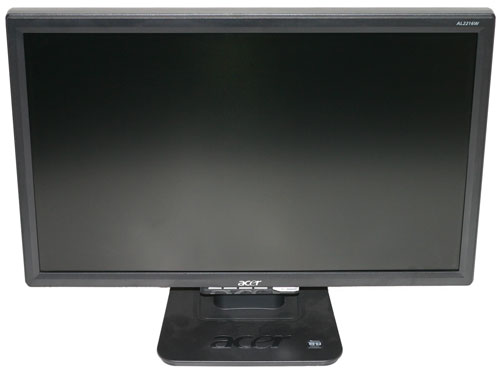 |
| Click to enlarge |
The side bezels are reasonably narrow, so if you're interested in setting up a multi-display environment this unit should work pretty well. A group of five buttons sits just below the main puzzle, providing access to the on-screen display (OSD) as well as power.
 |
| Click to enlarge |
The rear of the display is pretty nondescript, with the VESA wall mount and model information occupying the center area and the input and power connections facing downward towards the bottom of the panel. You can see the plastic hinge/mount that secures the panel to the base stand. As already mentioned, other than a reasonable amount of tilt, the base stand does not provide any adjustment options. The base stand also doesn't really convey a sense of durability, and applying enough force to tilt the monitor back seems to be more difficult than necessary, causing the plastic to flex slightly. The mounting location of the base stand (at the bottom of the panel) does not seem to work as well as the center mounts used on other LCDs.
 |
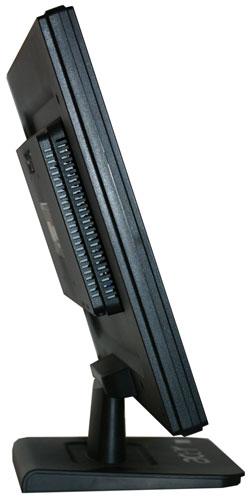 |
| Click to enlarge | |
Here you can see the tilt mechanism in full swing. It doesn't really tilt forward, but the backwards tilt should be enough for most people. There are no extra USB or other ports on the sides of the panel, unlike many higher end LCDs.
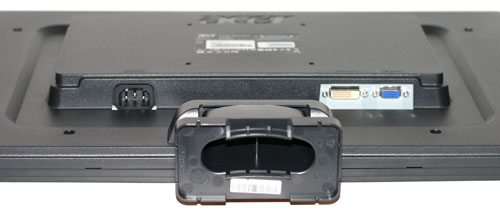 |
| Click to enlarge |
Like most LCDs, the two input ports and the power connection point downwards. The power connection is easy enough to install, but the video connections require a bit more work. Luckily, one advantage of the base stand is that it doesn't weigh very much or get in the way, so it's pretty easy to turn the LCD upside down so that you can get a good view of the ports. If you wish to tighten the thumbscrews that secure the VGA/DVI cables, we found it much easier to simply use a screwdriver. Should you choose to use both inputs, use of a screwdriver to tighten the thumbscrews is pretty much mandatory, at least for the two screws that are nearest each other.
Returning to the front of the unit, the four buttons on the bottom allow you to navigate the OSD. From left to right, the four buttons represent back/exit, left/decrease, right/increase, and select/enter. The far left button will also auto calibrate the display if you are using an analog connection. We found that the configuration is relatively easy to use and we were able to quickly navigate through the OSD. Here's a quick look at the various options in the OSD.
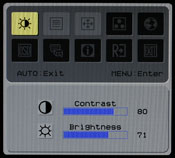 |
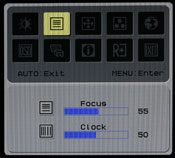 |
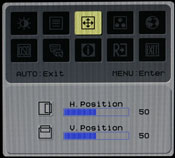 |
||
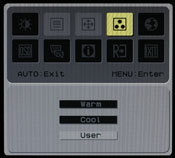 |
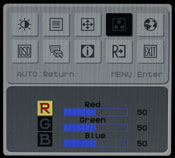 |
 |
||
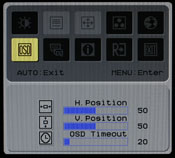 |
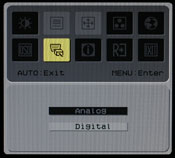 |
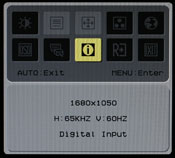 |
||
|
||||
| Click to enlarge | ||||
Unlike some of the other monitors we've reviewed, you get the ability to adjust both contrast as well as brightness. Most of the remaining functions are pretty straightforward. If you're using an analog connection, the second and third OSD options become accessible, allowing you to change the sharpening/focus as well as the screen position. The "clock" function appears to stretch/shrink the display width horizontally, which isn't immediately clear by the label. The focus option didn't seem to do a whole lot to improve the quality of analog images, though to be fair we did find in limited testing that the analog image was almost as good as the digital image.
If you use the digital connection, you don't have to worry about issues with screen centering or scaling, and you're guaranteed the clearest possible image. We tried to take some pictures that would allow comparing the quality of the analog signal versus the digital signal, but while we could see a slight difference with our eyes the camera wasn't quite able to pick up on the subtle variation, at least in the pictures we took. Also worth mentioning is that the auto calibration function does not perform properly with black borders/content - so for example, attempting to calibrate the display when the POST process is running results in improper calibration.
Overall, the Acer AL2216W appears to be a reasonable entry level 22" LCD. It lacks many of the features found on more expensive LCDs, and we definitely prefer the base stands that are used on many other LCDs over the stand Acer chose to use, but the display still appears more than adequate for most users. HDCP support is included, so you will also be able to watch protected content for the foreseeable future. Acer is generally known as one of the better budget LCD manufacturers, and the AL2216W continues the tradition. Not everyone will prefer a larger LCD that doesn't increase the native resolution, but considering the price is only slightly more than a comparable 20" LCD users basically get to choose between increasing size or saving a bit of money.


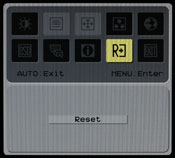
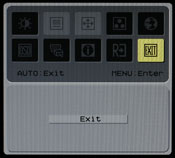








32 Comments
View All Comments
JarredWalton - Monday, March 12, 2007 - link
Newegg lists a http://www.newegg.com/Product/ProductList.asp?Subm...">bunch of 22" LCDs, with the Acer AL2223Wd and Chimei 221D being the cheapest. Actually, I'm curious as to what the difference in panel is between the AL2216Wbd and the AL2223Wd, as the latter has a better stand IMO. Looks like it has a slightly higher contrast as well - possibly a better display coating? Anyway, you can see in that list that specs are almost all identical between the 22" LCDs, so price and features are going to be the big factors.tercathian - Sunday, March 11, 2007 - link
w/ Base, (WxHxD)=20.2"x16.0"x7.8"; w/o Base,=27.16"x17.70"2.93". That base must reeaally scrunch things together! Otherwise another great Anandtech review. Glad to see monitors getting coverage again for a change.Upon visual comparison of BesBi's display lcd's, I passed on the Acer 22" that had a white line running top to bottom and picked the LG 22". Noticably crisper than any other brand, with purported 3000:1 contrast, for not much more $$$.
JarredWalton - Sunday, March 11, 2007 - link
Oops... yea, wrong display on the w/o stand measurements! I updated the size figures, for those that are interested. I'll also see about getting that LG LCD for review - looks interesting, as they may actually use something other than a TN panel.semo - Sunday, March 11, 2007 - link
1st, the color gradient for the gateway display links to the dell 2405fpw's (page 6).how does the dell 2405fpw look with an average delta e of 10.41? do you look at it and say "hmmm... something's wrong" even if there is no other display to compare it with? just wondering if a home user can detect color inaccuracies and do something about it or you get what you get and hope for the best (i assume a "home user" does not have access calibration equipment).
for the last several years i've largely ignored anything that has happened in display technology (other than glance over price tags) so imagine my surprise when i decided to bring myself up to date and found the crt is virtually extinct. i bought my pc and tv 5 years ago and crt was everywhere. i always thought i wouldn't switch to the thin stuff for decades and that my next tv would be a cheap hd ready tube.
anyway, i was wondering when will we see picture quality as good as crt used to provide and is lcd or plasma going to bring it to us. some of the displays at consumer shows seem to deliver the goods but anything that isn't plasma or lcd at the moment is just vaporware.
JarredWalton - Sunday, March 11, 2007 - link
Thanks for the link correction; that's fixed now for the Gateway chart.I'm not sure if the colors on the 2405FPW are just getting worse due to age or if it's always been off that far. If it's sitting next to another display display, I can certainly see a difference and the 2405 tends to look a bit washed out/yellow. If it's sitting alone on a desk, it actually doesn't bother me much, and going through some basic color calibration charts (i.e. calibrate by eye without the colorimeter) you can improve the colors to the point where it's about the same as the other displays (around 6-8 average delta E).
CRTs are dead/dying I think in part because they can't really be any cheaper to produce anymore. Even with current LCD prices, I'd wager the markup on all LCDs continues to be pretty good, while CRTs probably don't get more than a 10-20% markup because the market won't bear it. Especially quality CRTs cost quite a bit more to manufacture, and the companies that used to make such displays (Sony, NEC, etc.) have abandoned the CRT market as far as I'm aware.
yyrkoon - Sunday, March 11, 2007 - link
I still think 22" WS monitors cost too much, you can get a decent 19" WS for $179, so why the $100 markup for 3" diagonal ? It certainly cant be assurance against dead / stuck pixels . . .This is another problem I have with paying so much , eTailers, and manufactuers saying "must have 8 dead pixels, or more to replace monitor for a new one". That would be like me saying, "hey man, most of my money is not counterfit, but some of it is, but you can not have your monitor back, becasue you dont have a high enough percentage of bad vs good currency". Would be nice if these 'people' would come around to reality, this is the main reason I personally go through convoltions, every time I plunk down a good bit of my hard earned cash for a LCD . . .
I've yet to get any dead / stuck pixels, but I figure, it is just a matter of time. Anyhow, would be nice, if 'we the people' could 'rectify' this.
JarredWalton - Sunday, March 11, 2007 - link
The eTailers are just trying to protect themselves, and there's a simple solution: if you can't live with a few dead pixels, shop somewhere else. Local stores usually cost more but have better return policies.As for the cost, I paid $1100 for a 2405FPW 18 months back, and $300 for a rather lousy 19" LCD about the same time. Needless to say, while $300 may still be more than some people are willing to pay, prices have become much more reasonable across the board. It wasn't that long ago that 19" LCDs were at the $300+ price point for entry level models, and still people were willing to buy them.
yyrkoon - Sunday, March 11, 2007 - link
I understand WHY eTailers do what they do, but my whole point is basically, why are these companies (OEMs) getting away with what is obviously 'bad business'. I suspect this has to do with some 'fair trade' garbage, something a long the lines of why 3rd world countries are allowed to import food products into countries, that would not normally allow this food in to begin with ( IE, the food does not meet the countries standards for health and wellfare ).As for the bad 19" for $300, well, I too also paid ~$300 for one of mine (ViewSonic VA1912wb) around 12-18 months ago, and could not possibly be more pleased with it. Well, ok, maybe if it were free . . . Now, could you imagine, if you just spent $650 on a 24" WS, and had noticable bad pixels ANYWHERE on the screen ? Me, I'd be very upset.
All I'm really saying, is that 'we' need to let the OEMs this is not acceptable, until then, they will get away with whatever we let them get away with.
mindless1 - Monday, March 12, 2007 - link
It's real simple, they either have to sell the panels with the bad pixels or discard them (throw away if bad enough or divert to lower grade sales which is also a loss).If they take back these panels then it will cost more per monitor. They're not "getting away" with anything, if you don't like it don't buy their product. That's the catch, they can stipulate any return policy they like and won't have to alter it if they don't preceive it hurting sales.
It doesn't really hurt sales much because there aren't that many monitors with that many bad pixels, apparently they already sort the panels well enough that the sort criteria is lower than the defective product return criteria.
They're only getting away with it if/when someone actually has that many dead pixels. Who do you know that does? Unfortunately a lot of businesses have policies that (if I knew about them), would make be pause before doing business. You end up playing odds, what is your time worth to find a better policy and what other compromises are made with the alternative product? I have one LCD of several that has one stuck pixel. I can accept that as much as I can accept a bug in some other piece of hardware, as most hardware isn't perfect, it's just a matter of whether you notice the flaw or not.
yyrkoon - Sunday, March 11, 2007 - link
All I'm really saying, is that 'we' need to let the OEMs _know_ this is not acceptable, until then, they will get away with whatever we let them get away with.Anyhow, IM sorry that my little rant here, kind of hijacked the idea of this discussion area :/ It just seems, that 'the business', is slowly, but surely moving to a 'screw the cutomer for what they're worth' type attitude, and of course, this . . . sucks.
The good news is: From all the reviews of read on acer monitors over the last few months, have been very favorable on their behalf, at least concerning dead/stuck pixels, other issues do seem to pleague random models however, such as LCD not comming up until windows is booting (need to change BIOS settings ? SoL buddy . . .), to others not working properly with dual monitors attached to a video card ( monitor not operating at 'optimal' resolution).
Some of these issues would not likely bother the average user, while it would effect those who do need to adjust BIOS settings (without hooking up another monitor), or run dual monitors, etc, etc.